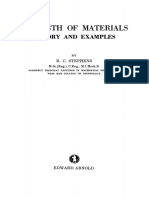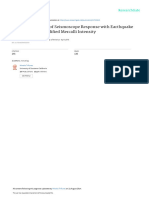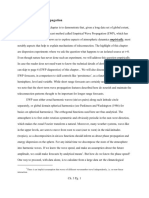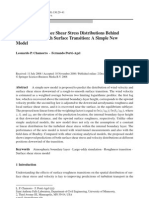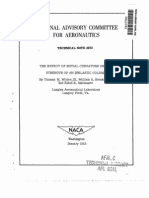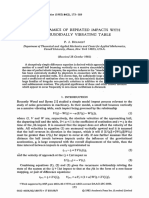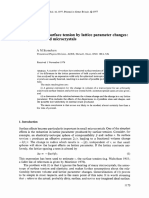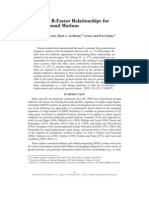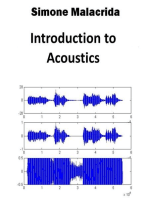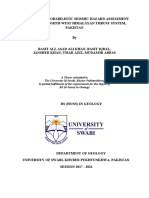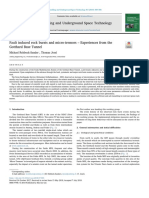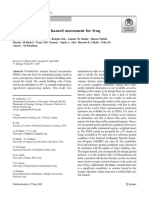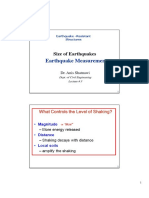Theoretical Basis of Some Empirical Relations
Theoretical Basis of Some Empirical Relations
Uploaded by
buitrungthongCopyright:
Available Formats
Theoretical Basis of Some Empirical Relations
Theoretical Basis of Some Empirical Relations
Uploaded by
buitrungthongCopyright
Available Formats
Share this document
Did you find this document useful?
Is this content inappropriate?
Copyright:
Available Formats
Theoretical Basis of Some Empirical Relations
Theoretical Basis of Some Empirical Relations
Uploaded by
buitrungthongCopyright:
Available Formats
Bulletin of the Seismological Society of America. Vol. 65, No. 5, pp. 1073-1095.
October 1975
T H E O R E T I C A L BASIS OF SOME EMPIRICAL RELATIONS IN SEISMOLOGY BY HIROO KANAMORI AND DON L. ANDERSON ABSTRACT Empirical relations involving seismic moment M o , magnitude M s , energy E s and fault dimension L (or area S) are discussed on the basis of an extensive set of earthquake data ( M s >= 6) and simple crack and dynamic dislocation models. The relation between log S and log M o is remarkably linear (slope ~ 2/3) indicating a constant stress drop Aa; Atr = 30, 100 and 60 bars are obtained for inter-plate, intra-plate and "average" earthquakes, respectively. Except for very large earthquakes, the relation M s ~ (2/3) log M o ~ 2 log L is established by the data. This is consistent with the dynamic dislocation model for point dislocation rise times and rupture times of most earthquakes. For very large earthquakes M s ~ (1/3) log M o ,,~ log L ~ (1/3) log E s . For very small earthquakes M s ~ log M o ,~ 3 log L ~ log E s . Scaling rules are assumed and justified. This model predicts log E s ~ 1.5 M s ,-~ 3 log L which is consistent with the Gutenberg-Richter relation. Since the static energy is proportional to 0L 3, where ~ is the average stress, this relation suggests a constant apparent stress ~/i where r/ is the efficiency. The earthquake data suggest r/0 ~ Atr. These relations lead to log S ,,~ M s consistent with the empirical relation. This relation together with a simple geometrical argument explains the magnitude-frequency relation log N N - M s .
INTRODUCTION The magnitude was the first quantitative measure of the strength of an earthquake. It is still the most widely used earthquake parameter although its shortcomings are well known. It is also the most difficult parameter to relate theoretically to other important source characteristics such as strain energy release, fault offset, stress drop, source dimension, moment and radiated seismic energy. These other parameters can be related, one to another, fairly easily, but their relationship to magnitude requires a spectral description of the seismic source. Such a description requires a complete time and space history of the faulting or stress release mechanism. For example, the magnitude is calculated from seismic-wave amplitudes at a given izeriod while the seismic energy release involves integration over the whole spectrum. The seismic moment is determined from the long-period level which may be quite removed, in period or frequency, from the period at which the magnitude is measured. In the first part of this paper, we summarize the relationships among the fault parameters which can be derived from static crack ordislocation theories. We then use dynamic theories of the faulting process to relate magnitudes to these other source parameters. In particular, we derive a general relationship between magnitude and radiated seismic energy. We derive the Gutenberg-Richter energy magnitude relation log E s ~ 1.5 M s and demonstrate under .what conditions it is valid. In the process, we show the relationship between magnitt/de, fault dimension, stress drop, and moment. These relationships depend on such dimensionless parameters as the ratio of rise time to total fracture time or ratios involving the coherence length, coherence time, and local rupture velocity. In going from static models to seismic measurements, param1073
1074
HIROO KANAMORI AND DON L. ANDERSON
eters such as efficiency, stress drop, and mean stress are also important. We will show that very simple crack and dynamic dislocation models can explain various important empirical relations observed for large ( M s > 6.0) earthquakes for which the observed data are most accurate and complete.
SOURCE PARAMETERS
From the static or geological point of view the important faulting parameters are dimension, /7, and average offset, /3. From these, and the material properties # (or 2 and #) the static moment, M o , can be calculated. The mean stress, 6, also is required to calculate the strain energy change, A W, associated with faulting. Some fraction, t/, of this is available for radiation as seismic energy. Three independent source parameters are therefore required to describe the statics of faulting; L, /9, and ~ or L, M o, and A W, for example. A parameter often used in discussions of fault mechanisms is the stress drop, Aa. This however, is simply # D/r,. A seismogram contains information relevant to all of the above parameters but to be interpreted must be corrected for distortion by the instrument and the Earth and for dynamic properties of the source such as rise time (z) and duration (tc) and direction of faulting. Although in some cases the rise time, or source-time function, can be determined from the seismogram, the information usually available is the amplitude at some frequency (the magnitude). The total energy contained in the seismogram and the longperiod level (the seismic moment) can be obtained from special studies using appropriate instruments. If all earthquakes are "similar", a measurement of amplitude at a single frequency defines the spectrum, and scaling laws such as those proposed by Aki (1967) can be used to estimate the other parameters such as moment and energy. This kind of scaling, in fact, is implicit in attempts to relate magnitude to energy (Gutenberg and Richter, 1956) or moment (Brune and Engen, 1969; Aki, 1967). In this paper the independent source parameters used most often will be S (fault area ~ L2), Aa (stress drop), t/tY (apparent stress), E s (seismic energy), M o (moment), z (rise time), and tc (duration of faulting = L / v where v is average propagation velocity). Assumptions of similarity and scaling and spectral source theories can be used to interrelate some of these parameters and to involve M s (magnitude) in the discussion. STATIC THEORIES Figure 1 summarizes the relationships between average offset,/), stress drop, Aa, and strain energy, AW, for circular faults (Eshelby, 1957; Keilis Borok, 1959), strike-slip faults (Knopoff, 1958) and dip-slip faults (Start, 1928). The dimensions of the fault are a (radius) or L and w (length and width) which we represent by L. For a vertical fault w is the depth interval over which displacement occurs. The mean stress, ~, and stress drop, Ao-, are (a0 +o'1)/2 and o-o - a 1 , respectively, where ~ro is the initial stress and al the final stress. The stress drop Aa is given by
A~ = c~(O/F3 (1)
where # is the rigidity, and C is a nondimensional shape factor. D/L = A~ is the representative strain change, or strain drop. For circular faults r, = a and C = 7~/16 (Eshelby, 1957; Keilis Borok, 1959). For shallow infinite longitudinal shear faults (strike slip), L, = w and C = 2/~ (Knopoff, 1958). For shallow infinite transverse shear faults (dip
THEORETICAL BASIS OF SOME EMPIRICAL RELATIONS IN SEISMOLOGY
1075
slip), L,= w and C = 4 ( 2 + # ) / n ( 2 + 2 # ) where 2 is the Lam6 constant (Starr, 1928; Aki, 1966). In all cases C ~ 1. In the latter two cases the free surface effect is included (Knopoff, 1958; Aki, 1966) For a finite rectangular fault of length L, relation (I) holds only approximately, but it is a reasonably good approximation (Chinnery, 1964; Sat, 1972). The change in the strain energy AWls given by
A W = S D 6 = ( L / C # ) S A a ~ = ( L / Z C # ) S ( a o Z - a ~ 2)
(2)
where S is the fault area The static moment M o is
m o = #SO = (L/C)SAa
= (#/6)AW.
The radiated seismic energy E s is
=
where ~ is the seismic efficiency of ~/< 1.
Circular
Strike Slip
Dip Slip
,~ Stress drop (Aa)
Strain energy (AW = ScrD) Moment
(;~ = It)
7n 16 (D) 2 [/3]
16it a
:-
~it 2it
__ w 2 L A a ~
aaAa#
n(2 + 210 w 2LAa# 4(2+p)it
( M o = ItS.D)
16 A a a a 7
n Aaw2L 2
n(2 + 2it) Aaw2L 40,+/0
FIG. 1. Relations between stress drop, strain energy, offset, dimension, and moment for static cracks. Dimensions of the fault are a radius, L length, w width; initial stress is a ; final stress is era ; stress drop
is Aa = a o - a l ; average stress is 5 = (ao + al)/2; average dislocation is/~.
DYNAMIC THEORIES
Consider a unilateral propagating fault of length L, width w, and area wL. The dislocation time function is assumed to be a linear ramp function of rise time z. Then, the amplitude spectral density [~c(~o)l of the far-field displacement in an infinite homogeneous medium resulting from this source is given by (Haskell, 1964),
I (.0~
]lfic(9)i_ # D L w [
sln~-
sin ~ -
~ot~
(3)
5-
where /) is the dislocation (offset), p the density, r the distance, uc the wave velocity, either P or S velocity, and R~, represents the radiation pattern (for notation see Haskell, 1964). tc is the rupture-time constant given by
tc = L / u - ( L / u c )
cos
where is the azimuth of the station measured from the rupture direction.
1076
HIROO KANAMORI AND DON L. ANDERSON
Aki's (1967) statistical model replaces z and L by two statistical parameters, correlation time k r - 1 and correlation length kL- 1. The function
(D'( (DrC
sm 5 -
sin
5
is replaced by
1
5-
L /
(4)
The asymptotic behavior of this function f o r small and for large co is identical to that of (3), if kL -1 ,-~ L and k r -1 ~ z. These relations are fundamental to the following discussions. The statistical models assume that a fault breaks coherently for only short distances, compared to the total fault length, and short times, compared to the total fracture time. The deterministic model (Haskell, 1964) assumes that the dislocation propagates uniformly along the fault. The statistical feature was introduced by Haskell (1966) in order to explain the high-frequency part of observed spectra.
MOMENT VERSUS SOURCE A R EA
The concept of seismic moment, introduced into seismology fairly recently, rests on the equivalence between elastic dislocation and a double-force couple (Steketee, 1958; Burridge and Knopoff, 1964; Maruyama, 1963 i Aki, 1966; Haskell, 1964). An earthquake fault is mathematically modeled by a shear displacement discontinuity (dislocation) across a surface g in an elastic medium. This dislocation is equivalent to a distribution of double couples on this surface whose total moment is
Mo = #SD
(5)
where # is the rigidity of the medium, D the average dislocation, and S is the area of E. The moment of this equivalent double couple is called the seismic moment. Since the dislocation is, in general, a function of time, M o is also a function of time t. In a restricted usage, the value of M o at t ~ m is called the seismic moment. In practice, however, the period at which the determination of M o is made depends on the kind of available data. Geodetic data give M o at t ~ ~ , long-period surface-wave or free oscillation data give M o at minutes and hours, and body-wave data, at relatively short periods. It is usually assumed that M o is determined at sufficiently long period so that it represents the value at t = o~. Although this assumption seems reasonable in many cases, it is not necessarily self-evident. It depends, in fact, on the behavior of the spectrum at long periods: Since long-period waves are less affected by structural complexities than the shortperiod waves used for the determination of earthquake magnitude, the seismic moment is one of the most reliably determined instrumental earthquake source parameters. For large earthquakes, in particular, the values of M o determined by different investigators seldom differ by a factor of more than two. For small earthquakes, the uncertainty is usually somewhat larger. Many reliable determinations of seismic slip and moment have been made by using geodetic, surface-wave, free-oscillation, and body-wave data.
THEORETICAL BASIS OF SOME EMPIRICAL RELATIONS IN SEISMOLOGY
1077
The physical dimensions of an earthquake source may be defined by the size of the fault plane or the aftershock area. When the earthquake fault is well defined by field observations or seismic directivity (Ben-Menahem, 1961), the area of the fault plane may be the most unambiguoas parameter representing the physical dimension of the source. However, when the source is suboceanic or the earthquake is too small or too deep to break the surface, the fault area cannot be determined directly. In these cases, the size of the aftershock area may be used instead to represent the physical size. Of course~ the aftershock area is not a completely unambiguous concept, but it has been shown for several Cases that the extent of the aftershock activity immediately after the main shock (hours or days) is consistent with the dimension of the fault length estimated by seismic directivity measurements (Benioff et al., 1961; Ben-Menahem and Toks6z, 1963; Kanamori, 1970a). However, in some cases, particularly for small earthquakes, the
6
-o
5 _--
Intra- Plate
. . ..X/..~ /
e20
~23,
_
%4
/
/ 17.,/ 7 /
,9
26" o3/4 /
' / "~-
22/7,~40ee .ig j
4 ? o/O_12 2d
35
25
26
27 Log
28 29 Mo, d y n e - c m
30
FIG. 2. Relation between S (fault surface area) and Mo (seismic moment). The straight lines give the relations for circular cracks with constant Atr (stress drop). The numbers attached to each event correspond to those in Table 1.
aftershock area tends to overestimate the fault area because of the uncertainty in aftershock locations and of the temporal expansion of the aftershock area. In this study, when the fault size is estimated by more than one method, the average is used. Details are given in the references to Table 1 which lists the fundamental earthquake parameters used in this study. A similar table has been published for 34 shallow-focus earthquakes i n t h e Tonga arc by Molnar and Wyss (1972). The seismic moment and the fault area summarized in Table 1 are plotted in Figure 2. This representation introduced by Aki (1972b) is similar to the one used by Hanks and Thatcher (1972) who used spectral parameters instead of physical parameters. In Figure 2, we classified the earthquakes into two groups, inter-plate and intra-plate earthquakes. The inter-plate earthquakes refer to those Which occur along, or parallel to, the major plate boundaries with a large slip rate. Major thrust earthquakes along subduction zones and along transform faults are classed into' this group. Earthquakes which occur clearly within the plate are intra-plate earthquakes. In the present paper, earthquakes whose
1078
HIROO KANAMORI AND DON L. ANDERSON are classed as intra-plate earthquakes, By this definition, the San Fernando even and
fault planes are not along the plate boundary though they occur near the plate boundary. Kern County
events are intra-plate earthquakes. TABLE 1 EARTHQUAKE DATA
No. 1 2 3 4 5 6 7 8 9 10 11 12 13 14 15 16 17 18 19 20 21 22 23 24 25 26 27 28 29 30 31 32 33 34 35 36 37 38 39 40 41
Event Kanto Tango N. Izu Saitama-1 Sanriku L o n g Beach Imperial Valley Tottori Tonankai Mikawa Nankaido Fukui Tokachi-Oki Kern County Fairview Peak Chile Kitamino W a k a s a Bay N. Atlantic Kuril Isl. N. Atlantic-2 Spain Alaska Niigata R a t Isl.-1 R a t Isl.-2 Parkfield Aleutian Truckee Peru Borrego Mt. Tokachi-Oki Saitama Portuguese Kurile Isl. Gifu Peru San F e r n a n d o Nemuro-Oki Turkey Iran
Date Sept. 1, 1923 Mar. 7, 1927 Nov. 25, 1930 Sept. 21, 1931 Mar. 2, 1933 Mar. 11, 1933 M a y t9, 1940 Sept. 10, 1943 Dec. 7, 1944 Jan. 12, 1945 Dec. 20, 1946 Jun. 28, 1948 Mar. 4, 1952 July 21, 1952 Dec. 16, 1954 M a y 22, 960 Aug. 19, 1961 Mar. 27, 1963 Aug. 3, 1963 Oct. 13, 1963 Nov. 17, 1963 Mar. 15, 1964 Mar. 28, 1964 J u n . 16, 1964 Feb. 4, 1965 Mar. 30, 1965 J u n 28, 1966 July 4, 1966 Sep. 12, 1966 Oct. 17, 1966 Apr. 9, 1968 M a y 16, 1968 July 1, 1968 Feb. 28, 1969 Aug. I1, 1969 Sept. 9, 1969 M a y 31, 1970 Feb. 9, 1971 Jun. 16, 1973 July 22, 1967 Aug. 31, 968
M~ 8.2 (5) 7.75 (12) 7.1 (1) 6.75 (1) 8.3 (1) 6.25 (1) 7.1 (13) 7.4 (1) 8.2 (16) 7.1 (1) 8.2 (16) 7.3 (1) 8.3 (1) 7.7 (1) 7.1 (21) 8.3 (21) 7.0 (2) 6.9 (z) 6.7 (26) 8.2 (21) 6.5 (26) 7.1 (33) 8.5 (21) 7.4 (21) 7.9 (21) 7.5 (21) 6.4 (37) 7.2 (26) 5.9 (s7)
7.5 (41)
(10z'z dyne-cm) 8.5 (6) 0.46 (11) 0.24 (7)
0 . 0 6 8 (9)
Mo
(10 a km 2) 6.9 (6) 0.49 (11) 0.24 (s)
0 . 2 (9)
43.0 (a) 0.028 (a) 0.56 (14) 0.36 (is) 15 (16) 0.087 (59) 15 (16) 0.33 (17) 17 (a) 2.0 (a) 0.15 (2) 2000 (22) 0.21 (24) 0.033 (25) 0.12 (26) 67 (27) 0.038 (26) 0.12 (33) 820 (29) 2.9 (31) 125 (34) 3.4 (36) 0.026 (as) 0.23 (26) 0.0083 (40)
2 0 (42)
18.5 (1) 0.45 (12) 0.78 (14) 0.43 (15) 9.6 (16) 0.132 (59) 9.6 (16) 0.39 (17) 19 (18) 1.4 (19) 0.22 (20) 200 (23) 0.57 (24)
0 . 1 6 (25)
0.35 (26) 44 (28) 0.24 (26) 1.0 (33) 130 (30) 2.1 (32) 78 (35) 4.0 (36) 0.26 (39) 0.42 (26) 0.1 (40)
11.2 (42)
6.7 (43) 8.0 (46) 5.8 (4s) 8.0 (4) 7.8 (2) 6.6 (2) 7.8 (4) 6.6 (s3) 7.7 (4) 7.1 (44) 7.3 (4)
0.067 (44) 28 (47) 0.019 (49) 6.0 (50) 22.0 (51) 0.034 (s2) 10.0 (42) 0.12 (54) 6.7 (56) 0.83 (Ss) 1.0 (58)
0.45 (45) 15 (47) 0.06 (49) 4.0 (50) 15.3 (51) 0.19 (52) 9.1 (42) 0.28 (55) 6.0 (56) 1.6 (Ss) 1.6 (Ss)
REFERENCES TO TABLE 1 (1) (2) (3) (4) (5) (6) G u t e n b e r g a n d Richter (1954) U s a m i (1966) or J M A (Japan Meteorological Agency) K a n a m o r i , unpublished data USCGS. M s (1) a n d average of 17 stations ( K a n a m o r i a n d M i y a m u r a , 1970) Average of K a n a m o r i (1971b) a n d A n d o (1971)
THEORETICAL BASIS OF SOME EMPIRICAL RELATIONS IN SEISMOLOGY REFERENCESTO TABLE1 - - C o n t i n u e d (7) (8) (9) (10) (11) (12) (13) (14) (15) (16) (17) (18) (19) (20) (21) (22) (23) (24) (25) (26) (27) (28) (29) (30) (31) (32) (33) (34) (35) (36) (37) (38) (39) (40) (41) (42) (43) (44) (45) (46) (47) (48) (49) (50) (51) (52) (53) (54) (55) (56) (57) (58) (59)
1079
Average of (3), Kasahara (1957), and Chinnery (1964) Average of (3), Kasahara (1957), Chinnery (1964), and Iida (1959) Abe (1974a) Kanamori (1971a) Average of Kanamori (1973) and Kasahara (1957) (3) and the aftershock area Richter (1958) Average of Brune and Allen (1967) and Byerly and DeNoyer (1958) Kanamori (1972b) Kanamori (1972a) Kanamori (1973) (3) and Utsu and Seki (1954) (3) and Richter (1955) Savage and Hastie (1966) Rothe (1969) Average of Plafker and Savage (1970), Kanamori and Cipar (1974) and Kanamori and Anderson (1975) Average of Plafker (1972) and Kanamori and Cipar (1974) Average of (3) and Kawasaki (1975) Abe (1974b) Udias (1971) Average of Kanamori (1970a) and Ben-Menahem and Rosenman (1972) Average of Kanamori (1970a), Santo (1964), and Ben-Menahem and Rosenman (1972) Average of Savage and Hastie (1966), Kanamori (1970b), Abe (1970), Ben-Menahem, Rosenman and Israel (1972), and Alewine and Jungels (1973) Average of Algermissen et al. (1969), Savage and Hastie (1966), and Kanamori (1970b) Average of Aki (1966), Hirasawa (1965), and Abe (1975b) Average of Aki (1966), Kayano (1968), Hirasawa (1965), and Abe'(1975b) Udias and Arroyo (1970) Average of Ben-Menahem and Rosenman (1972) and Wu and Kanamori (1973) Average of Jordan et al. (1965), Ben-Menahem and Rosenman (1972), and Wu and Kanamori (1973) Abe (1972a) Wu (1968) Average of Tsai and Aki (1969), Scholz et al. (1969), and Trifunac and Udwadia (1974) Average of Eaton et al. (1970) and Trifunac and Udwadia (1974) Tsai and Aki (1970) Average of Pasadena and Berkeley Abe (t972a) Average of nine stations Hanks and Wyss (1972) Average estimated from surface rupture and aftershock area quoted in Hanks and Wyss (1972) Average of JMA, Pasadena and Berkeley Kanamori (1971c) Average of Abe (1975a) and JMA Abe (1975b) Fukao (1973) Abe (1973) Average of (3) and Mikumo (1973b) Average of 39 stations Average of Wyss (1971), Wyss and Hanks (1972), Canitez and Toks6z (1972), Mikumo (1973a), Savage et al. (1975), Jungels and Frazier (1973), Trifunac" (1974) and Alewine (1974) Average of Allen et al (1971), Wyss and Hanks (1972), Canitez and Toks6z (1972), Mikumo (1973a), Trifunac (1974), Savage et al. (1973) and Whitcomb et al. (1973). Shimazaki (1974) Average of seven stations (44), Ambraseys and Zatopek (1969) and Ambraseys and Tchalenko (1969) Ando (1974)
1080
HIROO KANAMORI AND DON L. ANDERSON
The most striking feature of Figure 2 is the remarkable linearity with a slope of 2/3 between log S and log Mo. This linearity is usually explained in terms of "constant stress drop". For constant rigidity this implies "constant strain drop." For a circular fault, we have from (1) and (5)
M o = p S D = 16 Atra 3
7-
= \ 7~]
//16 Ao'~ S3/2
(6)
or
3 log M o = 2 log S + log (16 Ao'/77z3/2).
(7)
Thus, for a constant Ao-, log S ,,~ 2 log M o as shown in Figure 2. For rectangular faults, the constant term depends on the square root of the aspect ratio, w/L. We will use the simplest circular model for the purpose of the present discussion. Figure 2 shows the relation (7) for four different stress drops. The most remarkable feature is that the large inter-plate earthquakes for which both S and Mo are most accurately (perhaps _ 30 per cent) determined align with a very small scatter between the lines for 10 and 100 bars. A stress drop of 30 bars is indicated for this group of earthquakes. On .the other hand, intra-plate earthquakes indicate systematically larger stress drops, about 100 bars. This conclusion is in general agreement with the observation that several intra-plate earthquakes involve higher stresses (Sykes and Sbar, 1973). Molnar and Wyss (1972) found that some events that occur within either the Pacific or Australian plates have higher stress drops than events with the same moment that occur on the boundary of these two plates. If no distinction is made between intra-ptate and inter-plate earthquakes, a gross average of 60 bars may be used as a representative value of stress drop for large earthquakes. This stress drop corresponds to a strain drop of (60 106)/ (3 x 1012) ~ 2 x 10 -4 which agrees, within a factor of two or so, with a value suggested by Tsuboi 0956) for the critical strain of the Earth's crust. Chinnery (1964) and Aki (1972b) concluded, although on relatively few data, that the stress drop in shallow earthquakes is 10 to 100 bars. The more complete data-set presented here substantiates this conclusion. This type of general relation has also been found for smaller earthquakes by Wyss and Brune (1968), Thatcher and Hanks (1973), and Ishida (1974), but the scatter is much larger, the stress drop ranging from 0.5 to 300 bars. This large scatter may partly represent small scale heterogeneity of the stress field in the crust, but is also due to errors in the dimensions which are determined, in most cases, from the "corner frequency". Since the stress drop is proportional to the cube of the corner period, a small error in the corner period results in a considerable error in the stress drop. q-he small scatter in the log S versus log Mo diagram for larger earthquakes strongly indicates that the constant stress-drop model (i.e., constant strain drop, D/L) is a very good model for large earthquakes.
MAGNITUDE VERSUS MOMENT
The surface-wave magnitude M s is determined from the logarithm of the amplitude of surface waves at a period of 20 sec, while the seismic moment M o is measured, in principle, at infinitely long period. Since surface-wave energy is ultimately derived from
T H E O R E T I C A L BASIS O F SOME E M P I R I C A L R E L A T I O N S I N S E I S M O L O G Y
1081
elastic-wave radiation from the source, the dependence of surface-wave amplitude on the spacio-temporal characteristics of the source should be governed by equation (3), or similar relations. Thus, the relation between M o and M s can be obtained directly from (3), if we introduce the following similarity conditions L
W
Cl
const
(aspect ratio)
(8)
L = c2 = const
V'C -- =
(strain drop)
(9)
C3 =
const
(dynamic similarity).
(10)
(8) represents a geometrical similarity which seems reasonable for most earthquakes. (9) represents constant Aa (or strain drop) which is shown, in the preceding section, to be valid for large earthquakes, and (10) represents a dynamic similarity which implies constant effective stress. This last point will be discussed later. With the similarity conditions (8) and (9)the seismic moment Mo = p S D ,.~ L 3. On the other hand, the magnitude M s is proportional to log luc(co)[ at co = coo = 2 n / T o (To = 20 sec). If we consider the "average azimuth" O = x/2, then
M s ,.~ log | D L w
sln
COO'[
coo LI-1
sin ~- ~ l
coo t
(11)
_1
The function
I. co0 l I. cooL
in the above relation takes the following asymptotic values depending on "cand L/v
vT - L -1
~L 1 To - L_ 1
71; T
if~ < T and L- > To 7r v i f r > T a n d L < To
71: V
F(r, L/v) ,'. To z v 1
71:2 L T
L_ 2
i f z > To a n d L > To
71: /3 7/:
1 -- L
i f z < T a n d -L < To.
1082 Thus
HIROO KANAMORI AND DON L. ANDERSON
log L z
if'r < To and L > To 7E /2 /~ if > __Tand L_ < _T o
7Z /) 7~
log L 2
M~ ~
log L
if "r > T- and _L > _T
7[ U 7Z
log L 3
if "r < To and L
7~ /3
TO
7~
Figure 3 shows the dependence o f M s on L in the four quadrants on (~, L/v) plane. Although determinations of the rise time ~ are relatively few, available data for about ten
~'"I ' ' ' I
IOO 50
I_)
I
-
Ms~ Log L 2
Log MO" 1.5 M s
t~amchatka
I'
Ms--- log Ls~ I
og MO"3M
I
/ /
Kern ~ i n , l I r
, i I~-I ~
I Kitamin( 'c
ai'kfield ~ [/
.J
"
o
Io Giful~l I~ IIIWokoso B. LI FI I!I Soitama ,-5 F--[ ~h ~, Fe;nondo /
L/v = 20/=
I-[lMs-lOg LSl / log M /
! , r = 2.~_0
Ms~ Log L 2
Log MO"I.5
i I lllJl,/
0.5 I
Msl
Ioo
p i I I III
5
Io
I Ill
50
T, sec
FIG. 3. Relations between rupture time L/v and rise time ~. The dependence of Ms on L and Mo is shown for each quadrant. The earthquake data are taken from the references in Table 1, and BenMenahem and Toks6z (1963) for the Kamchatka earthquake. earthquakes fall mostly within the quadrant for M s "~ log L z as shown in Figure 3. Thus for most large earthquakes for which M s can be determined, we may put M s N log L z. Combining this with M o ~ L 3 we have 3 log m o ~ 2 M s . (12)
The physical interpretation o f these results is as follows; ~ < To/n corresponds to "rapid" rise-time events ( < 6 sec). Compared to 20 sec, most seismic events can be considered to have rapid rise times because o f the efficiency of generation o f 1-sec P waves. Therefore, M s ~ log L 2 or log L 3 will hold for the majority o f events. The term L / v is roughly equivalent to the total time duration o f faulting. F o r reasonable propagation velocities the inequality L / v > To/~ is almost certainly satisfied for L > 18 k m or M s > 6.5. Therefore, most large earthquakes will satisfy M s N log L 2.
T H E O R E T I C A L BASIS O F SOME E M P I R I C A L R E L A T I O N S I N SEISMOLOGY
1083
Very small earthquakes with short rise times and small dimension are likely to satisfy M s ,,~ l o g L 3. The conditions z > T o / ~ and L / v > T o / ~ may be appropriate for slow precursors (Kanamori and Anderson, 1975), tsunami-generating earthquakes of moderate magnitude and mid-Atlantic ridge events which generate large surface waves but small body waves. For large dimension earthquakes with long rise times M s "~ log L. We have discussed only surface-wave magnitude but the same arguments hold for body-wave magnitude except that characteristic times are now to be compared with 1 sec rather than 20 sec. In this case, only very small earthquakes can be expected to scale as m b ,,~ log L 3 and more earthquakes can be expected to satisfy the mb ~ log L 31
30
29 E O
I "O
2; _3
t3~ O
27
26
25
24
Ms
FIG. 4. Relation between Ms (20-secsurface-wavemagnitude) and Mo. The straight lines are for constant apparent stress. A rigidity of 3 x 1011 dyne/cm2 is used. scaling. However, the validity of the similarity conditions is not very obvious for small earthquakes, and the scaling relations may be more complicated (Aki, 1972a). Since the relation between magnitude and fault length depends on the period of the seismic wave being observed, the M s - mb relation will not be linear over a large magnitude range. Most explosions probably satisfy M s and mb ~ log L 3 (where L is the cavity radius). Figure 3 indicates an approximately linear trend between the observed L / v and z which justifies the dynamic similarity condition (10). Figure 3 also indicates that if the fault length exceeds a certain limit, 100 km or so, then the M s ~ log L 2 relation (i.e., log M o 3/2 M s ) should be replaced by M s ~ log L relation (i.e., log M o ~ 3 M s ) . Thus for extremely large earthquakes, such as the 1960 Chilean, 1964 Alaskan, and 1965 Rat Island earthquakes, we expect a log M o ~ 3 M s relation. Figure 4 shows the relation between
1084
HIROO KANAMORI AND DON L. ANDERSON
log Mo and M s for earthquakes listed in Table 1. The slope of 3/2 is indicated by the straight lines in the figure. Although the scatter is considerable, the general trend is consistent with a slope of 3/2 except for very large earthquakes which indicate a much steeper slope corresponding to the log Mo N 3 M s relation discussed above. Thus, for large earthquakes, the simple dynamic dislocation model with the similarity conditions seems to be an adequate model. In the above, we used a one-dimensional unilateral rupture. In actual faulting, however, the rupture can be two-dimensional, rectangular (Hirasawa and Stauder, 1965) or circular (Savage, 1966; Sato and Hirasawa, 1973), and bilateral, symmetric or asymmetric, and the critical values o f L/v and depend on the mode of rupture. For example, for bilateral faultings, L in (11) should be replaced by L/2. For circular faults, Sato and Hirasawa (1973) showed (their figure 4) that the critical value of L/v is about To/n. These differences in rupture mode, however, would not drastically affect the present conclusion. Also, we considered the "average azimuth" O = n/2, but this choice does not affect the present results either. Haskell (1964) integrated
Ogtc]
I
over the whole space, and obtained a function B2(~o) which is similar to
. o~L/~oL'~
(figure 4 in Haskell, 1964). Using this function leads to about the same critical value
o f L/v.
The same conclusion may be reached by using Aki's (1967) statistical model with the same similarity conditions. Although the statistical parameters kr~ and kr do not explicitly represent specific physical quantities, it seems reasonable, in view of the similarity conditions, to put k L- 1 L and k T- 1 ~ ,~. 3-hen, it follows from (4) that
N
log L 2
log L 2
1 To 1 To for v~L > ~ and ~ < 2~r-for ~
1
1
To 1 To < ~ and kT > 2~
(13)
Ms ~
log L log L 3 Thus for the first two cases we have
for ~ for ~
To 1 To > 27r and kr > 2~
To 1 To < ~ and kr < 2re--"
log M o ~ ~ M s . The preceding discussion is analogous to Aki (1967); however, Aki more or less arbitrarily put vk L = k T (dotted line in Figure 3), and therefore his sealing law predicts an abrupt transition from log Mo ~ 3 M s to log Mo ~ M s (see figure 4 of Aki, 1972a). As shown in Figure 3, the observed data for and L seem to suggest L/v ,~ 10z or kr ~ 10 VkL,
THEORETICAL BASIS OF SOME EMPIRICAL RELATIONS IN SEISMOLOGY
1085
and therefore log Mo ~ 3/2 Ms for a considerable range of magnitude. The observed values of Mo and Ms shown in Figure 4 clearly show that this relation holds for large earthquakes. Aki's emphasis is on the overall difference in the sFectral characteristics between large and small earthquakes, and replacing k r "~ vkz by k r ,,~ 10 VkL would not significantly affect his conclusions, as Aki (1967) mentioned briefly. Brune and King (1967), Brune (1968), and Brune and Engen (1969) introduced log Mo versus Ms diagrams which consist of two segments each having a slope of 1. Since they determined the moment at 100-sec period, their relation cannot be directly compared with Figure 4. The dynamic similarity condition vz/L = const can be given the following physical meaning. The rise time of the dislocation function depends on the effective stress. Brurle (1970) showed that the effective stress ae,o (the initial tectonic stress, ao, minus the frictional stress, as, opposing the fault motion, i.e., ae,o = ao-tr I) and the dislocation particle velocity b are related by /) = 2 -'-fl #
O'e o
(14)
for infinite rupture velocity. For finite rupture velocity (v ~ fi), it can be shown that (Kanamori, 1972b)
~ O-e, 0 --.
(15)
Since/) ,-~ D/z, a n d / ) ,-~ L, similarity condition (9), (15) suggests
VT
N ~re~o -1
(16)
Thus the dynamic similarity condition is equivalent to constant effective stress. Since determinations of effective stress are very few, the constancy of the effective stress is not so well established as that of the stress drop. However, the data, plotted in Figure 3, showing vz/L ,,~ constant, and a determination of the effective stress in the frequency domain by Trifunac (1972) suggest that the effective stress is, on the average, about constant for large earthquakes. This is reasonable since the effective stress is even more a material property than the stress drop.
MAGNITUDE 'VERSUS ENERGY
The relation between the surface-wave magnitude Ms and the total energy of seismic waves Es has been studied by many investigators, among others, Gutenberg and Richter (1956) and B~tth (1958). After several revisions Gutenberg and Richter (1956) obtained a relation l o g E s = 1.5Ms+ll.8 (17)
(see Richter, 1958, page 366. The constant 11.4 used in this reference is a misprint, and should read 11.8). B~tth (1958) integrated the surface wave trains to establish the relation between the surface-wave energy e s and Ms. Combining this relation with a relation between e~ and the total energy~ E s, B~th (1958) finally arrived at a relation log E s = 1.44 Ms+ 12.24 (18)
which is very similar to (17). Ms represents the level of the energy spectrum at 20 sec while E s represents the integral of the spectrum over the entire frequency band. Thus,
1086
HIROO KANAMORI AND DON L. ANDERSON
implicit in (17) or (18) is a certain similarity condition by which the energy spectral density at 20-sec period can represent the whole spectrum, or at least the integral of the spectrum. The above relations (17) and (18) imply that
Es ,.~ 101.5 ~ts
(19)
This relation, of course, has been introduced empirically, but we shall show in the following that it can be explained in terms of the simple dislocation model we used in the previous section. Using the amplitude spectral density [uc(co)[ and the same approximations as we used before, we have
I . (DT 2
fo~
E~ ~ ~o~lu(~o)[
d~o ~ t~w~9 ~
f,
~o ~
sln~
- -
sincL 2 2vl d~o
o
~ ~ v}
12 2o,
sin _y2 s i n 2 Y Z
(x)=f:y2-~_22-
where
Isin~f
(21)
dy.
Using the similarity conditions (8), (9) and (10), we have (L/w) = const and L2w2D2/'C 3 L a; therefore
~
Es ~ L 3. Remembering
M s ~ log L 2
(22)
(23)
for large earthquakes, we have, from (22)
Es ~ 10 ~'5 Ms
which is the empirical relation (19). Aki's (1967) statistical model leads to the same since (4) gives
Es ~
(w 2 D2L 2)
(.02
7~ W2D2L2(kT)2(kLV)
1 k~v + kT
La
where the similarity conditions (8), (9) and (10) are used. Brune's (1970) model also leads to E s ~ L 3 as shown by Hanks and Thatcher (1972). It is interesting at this point to compare (22) with the energy relation (2) for the static model. The seismic-wave energy E s may be expressed by
Es = 11 A W = ~ISDe = q- Mo~
(24)
THEORETICAL BASIS OF SOME EMPIRICAL RELATIONS I N SEISMOLOGY
1087
,-~ L 2,
where q is the seismic efficiency. If we use the similarity conditions,/) ~ L, and S we have
E s = q - M o ~ ~ r16 L 3
(25)
where a a = r/6 is the apparent stress (Aki, 1966; Wyss, 1970). Comparison of this with (22) implies that the apparent stress 0.a is constant (i.e., independent of L) for large earthquakes. This is a rather important result which simply arises from the fact that the simple dislocation model together with the similarity conditions predict E s ,., L 3, while a simple static model predicts E s ~ cr, L 3 dependence. Combining (25) and the Gutenberg-Richter energy relation (17), we have log M o = I. 5 M s + (11.8 - log (0.a/fl))" (26)
This relation can be compared with the observed log M o versus M s plo{ shown by Figure 4. As discussed before, for very large earthquakes with fault lengths exceeding 100 km or so (e.g., Chile, 1960; Alaska, 1964; Rat Island, 1965), this relation is not valid. The data points for these earthquakes are bracketed in Figure 4. Although the scatter is considerable, there is a trend that the intra-plate earthquakes have systematically higher o, than inter-plate earthquakes. Very crude estimates would be 0.a ~ 10 to 20 bars for inter-plate, aa ~ 50 bars for intra-plate, and aa ,,~ 30 bars for the "average" earthquake. Comparing these values with the values of stress drop A0. (Figure 2), we note that 0.a ~ A a . Although this result involves various uncertainties such as geometry, rigidity, rupture mode, energy-magnitude relation, etc., it is interesting to compare this with the Savage-Wood (1971) inequality o, < A0./2. (27)
This relation results from the fault model of Orowan (1960) and the assumption that the frictional stress 0.y during the slippage is greater than the final stress 0.,. In terms of the average stress 6, frictional stress as and the average dislocation, the efficiency r/may be written as ~-I / = ~D-0.sD = 6 - a s ~y/~
or
(28)
as = ff-0.a. Thus if~rs > 0.1 we have, from (29),
(29)
which is the Savage-Wood inequality. Our results 0.~ ~ Aa therefore suggests that the final stress is approximately equal to the frictional stress 0.f, i.e., 0.y ~ 0.1. For several earthquakes for which the effective stress O-e, and A0. are independently determined, the o results indicate 0.e,o ~ A0. (Kanamori, 1972b; Abe, 1974 a,b, 1975a). Since 0.e,o = 0 . o - 0 . s and A0. = 0.o-0.2, these results indicate 0.f = 0"1 which is consistent with the result obtained above. From (28), 0.f being replaced by a~, we have t/6-as _ e 6 2-e (30)
where e is the static fractional stress drop, e = zXa/0.o. By using (30), we can estimate 0.o, and t/ for intra-plate, inter-plate and "average" earthquakes for various values of
1088
HIROO KANAMORI AND DON L. ANDERSON
(or tr:/Cro). The results are shown in Table 2. Since the frictional stress cannot be determined by seismological methods alone, it is not possible to nail down the efficiency and the initial tectonic stress cro. The results in Table 2 are interesting, however, in relation to the recently developed dilatancy model of an earthquake. Laboratory experiments on rocks suggest that "kilobar stress" is necessary for the onset of dilatancy. On the other hand, earthquake data invariably suggest 10- to 100-bar stress (either stress drop or apparent stress), which is significantly lower than the laboratory stress. This disparity, however, can be removed, as Table 2 indicates, if a frictional stress is larger than 90 per cent of the tectonic stress; in this case only a part of a "kilobar" tectonic stress is released in earthquakes. Wyss and Molnar (1972) suggested a value of 0.01 to 0.1 for for Denver, Colorado, earthquakes.
TABLE 2 FRACTIONAL STRESS DROP (e), FRACTIONAL FRICTIONAL STRESS tT:/ao, EFFICIENCY (t/), INITIAL TECTONIC STRESS (frO), STRESS DROP (Aa) FOR INTER-PLATE, INTRA-PLATE, AND AVERAGE EARTHQUAKES* tro (bar) e cry -Oo
0 0.2 0.4 0.6 0.8 0.9 0.95 0.99
Inter-plate Intra-plate "Average" (Act: 30 bar) (At,= 100 bar) (A~r~60 bar) 30 38 50 75 150 300 600 3000 100 125 170 250 500 1000 2000 10000 60 76 100 150 300 600 1200 6000
1.0 0.8 0.6 0.4 0.2 0.1 0.05 0.01
1.0 0.67 0.43 0.25 0.11 0.053 0.026 "0.005
* %~era = 1 - e, ~ / = e l ( 2 - e ) , fro = Acr/e.
It should be noted that various assumptions and simplifications have been made in the above discussion. For example, the possible change in gravitational energy associated with earthquake faulting (Jungels and Frazier, 1973) is not considered. Inclusion of this type of energy would affect the energy budget and, therefore, the efficiency. Also, generation of high-frequency energy may not be properly modeled by the simple dislocation model used here. This high-frequency energy is to some extent taken care of by the empirical constant 11.8 in the log E s versus M s relation, but detailed discussions are not possible unless more precise estimates of the energy are made in the near-field.
M A G N I T U D E VERSUS F A U L T AREA
The simple dislocation model, with the similarity conditions, leads to a straightforward relation between M s and the fault surface area S. For a circular crack, we have from (2) and (24),
E s = r / A W = 16
7-~ ~
-3/2yid. Ao, S3/2 "
Combining this with the log E s versus Ms relation, and eliminating Es, we have 2j log S = Ms+8.13-~, l o g\~t/A~o" ) [-- a
,
(31)
THEORETICAL BASIS OF SOME EMPIRICAL RELATIONS IN SEISMOLOGY
1089
Thus, if Aa and ~. are constant as we have shown, log S should be proportional to Ms. In fact Utsu and Seki (1954) found a linear relation log S = 1.02 M - 4 . 0 1 (S in square kilometers) between the aftershock area and the magnitude (Figure 5). The aftershock area may be considered approximately equal to the fault area. The magnitude scale used by Utsu and Seki (1954) is the JMA (Japan Meteorological Agency) scale which is not the regular surface-wave magnitude Ms, but is calibrated against Ms closely (Tsuboi, 1957). Figure 5 includes the data listed in Table 1 but not used by Utsu and Seki (1954). As shown in Figure 5, the data points for the 1960 Chilean earthquake, the 1964 Alaskan earthquake and the 1965 Rat Island earthquake deviate significantly from the general trend. This deviation is due to the inappropriateness of the E s versus M s relation for such large earthquakes with very large fault dimensions. Except for these earthquakes, the
6
-
'
'
'
// /"
/.~
Ms vs. Fault Area o Utsu and Seki (1955) Additional Data
,og s =,.OZM-4.o,
(o)1~" (e)23 / / 1
~4__-:
~ n - -
//oOo
./o
o ~ , ~ oj L . \0
e34 ./
-~
//_5--
o o o _~o ~ o /~ /.39
_I
o .o~Io'~m o
el4
/"
3_ /
o
0
/9/~28
0"0
o
// /
.//
.
=
__C
el5
e..~l)e 19
/ / / / 2 7 o\e-56 ,18 / / ~\21 //
29 I
//I
,
7.5
I
8.0
33 6.0
6.5
7.0
8.5
9.0
Ms
F;G. 5. Relation between Ms a n d S (aftershock area, fault surface area). T h e straight lines are for c o n s t a n t a p p a r e n t stress. T h e rigidity Ft a n d stress drop of 3 x 10 t t d y n e / c m 2 a n d 60 bars are used.
general trend gives a slope of 1.0. If we use Aa = 60 bars for the "average" earthquakes, a, of 2 to 70 bars is consistent with the data. As shown in Figure 5, aa = 7 bars gives a relation which is very close to the Utsu and Seki (1954) relation. In other words, the Gutenlzerg-Richter relation log Es = 1.5 M s + l l . 8 and the Utsu-Seki relation log S = M s - 4 (S in square kilometers) suggest o-a ~ 7 bars under the assumptions of circular fault, p = 3 1011 dyne/cm 2 and Aa = 60 bars. The relatively large scatter in the Ms versus log S diagram is partly due to the ambiguity in the aftershock area. Utsu and Seki (1954) did not clearly define it, but they seem to have taken the area which includes all of the aftershocks during a considerably long period of time after the main shock. The aftershock area thus defined tends to overestimate the fault size. Nevertheless, i t is notable that this independent set of data suggests, aa of 2 to 70 bars in general agreement with the value estimated 'from the log Mo versus Ms relation, about 30 bars. B~th and Dude (1964) suggest a somewhat different relation log S = 1.21 M s - 5.05 (S in square kilometers)
which is in general agreement with Utsu and Seki (1954).
1090
HIROO KANAMORI
AND DON L. ANDERSON
Tsuboi (1956) assumed that the total energy of an earthquake E is given by E = ex 2 V where e is the effective elastic constant, x is the ultimate strain and V the "earthquake volume". Using this energy in the log E s versus M s relation, Tsuboi derived the Utsu and Seki (1954) relation. Implicit in his derivation are, in terms of the present model, the assumptions of complete stress drop (in the relation E = ex 2 V) and 100 percent efficiency (t/ --- 1.0). Thus Tsuboi's model is a special case of the present model. He used x = 10 -4 which corresponds to Aa = / ~ x = 30 bars. The assumption of complete stress drop and t/ = 1 gives t/tY = Act. Putting these into (31), we have log S = M s - 4.0 (S in square kilometers) which is essentially the Utsu and Seki (1954) relation. MAGNITUDE VERSUS FREQUENCY The magnitude-frequency relation is given by log N = a - b M s (32)
where N is the number of earthquakes in a certain magnitude range Ms+_AMs, or the number of earthquakes larger than Ms, in a certain area, and a and b are constants. Except for some volcanic events, the value of b has been found to be very close to 1. This result can be explained in terms of a simple geometrical consideration. Consider an area E, and let N(Ms) and S(Ms) be the number and the fault area of earthquakes within a magnitude range around Ms in this area. Since the smaller the S(Ms), the more faults can be accommodated in Z, it seems reasonable to put
N(Ms)S(Ms) ~ X = const.
(33)
Then log N ,~ - l o g S. Combining this with (31), we have log N ,.~ M s. (34)
Thus the observation that the b value in the magnitude-frequency relation is close to 1 can be explained by a geometrical relation given by (33). It is important to note that the relation S N 10~s we used above came from E s ,,~ 10 ~'5/~s to which we gave a physical explanation on the basis of the simple dislocation model. The recurrence time of an earthquake of magnitude M is proportional to N -~, thus z ,-~ N - 1 ~ S ~ L 2. This implies that if the rate of various processes associated with earthquakes, such as strain rate, etc., is uniform, other times such as various precursor times scale the same. The z ,-~ L 2 relation does not imply diffusion. DISCUSSION We have determined the following theoretical relationships, log Mo = 1.5 log S + l o g Ao-+log C where C = 16/77za/2 (circular faults) (strike slip) (dip slip).
= (Tr/2)(w/L) 1/2
= n(2+2#)(w/L)~/2/4(2+#)
THEORETICAL BASIS OF SOME EMPIRICAL RELATIONS IN SEISMOLOGY
109I
The seismic data are consistent with this relation and imply stress drops, Ao-, of 30 and 100 bars, respectively, for inter-plate and intra-plate earthquakes. Radiated elastic energy, E s , is
Mo
#
Therefore log E s = log M o + log (~l~//z) = 1.5 log S + log Ao"+ log (q6) + log C. The apparent stress, cra = ~/6, is 10 to 20 bars and 50 bars, respectively, for inter-plate and intra-plate earthquakes. Therefore t16 ~ A a / 2 . By assuming geometric and dynamic similarity we obtain
M s = log(DLnw)+b
= logLn+2+b'
where n = + 1, 0, - 1 depending on the ordering of the characteristic times, z and to, and the measurement period T o ( ~ 20 sec for M s and ~ 1 sec for rob);
Ms ~ Ms ~ M s "~
log E z ~
(2/3) log Mo ~ (2/3) log E s (most moderate to large earthquakes)
log E ,-~ (1/3) log M o ~ (1/3) log E s (long rise time large events) log L 3 ~ log M o ,,. log E s (very small earthquakes).
The relation log E s ~ 1.5 M s is the Gutenberg-Richter relation and is appropriate for most events. However, log E s ~ 3 M s and log E s ~ M s hold for the special cases noted above. The geometric similarity condition w ,,~ L may break down for large earthquakes if there is a maximum depth over which brittle fracture occurs. This may hold for large transform-fault events where w < 20 km regardless of the length. In this case, w ,,~ const and, from A~ ~ D / w = const, 13 ~ const. Therefore ~ ,,~ D / v = const, and, from (l 1), M s ,~ L . Thus the magnitude does not depend on fault length although the moment, M o = ~ D w L ~ L , does.
CONCLUSION
An extensive data-set of the seismic moment M o and the fault surface area, S, for large earthquakes ( M s > 6) demonstrates a remarkably linear relation between log S and log M o with a slope of 2/3 indicating a constant stress drop, Aa, for large earthquakes. Ao- = 30, 100 and 60 bars are suggested for inter-plate, intra-plate and "average" earthquakes, resFectivety. Except for very large earthquakes, the relation log M o ~ 1.5 M s (20-sec surface-wave magnitude) is established by the data for large earthquakes. This relation can be explained in terms of a spectral shape of seismic radiation predicted by a very simple dislocation model such as Haskell's (1964). This dislocation model predicts a relation log E s ~ 1.5 M s ( E s , the total radiated wave energy) consistent with the empirical M s versus E s relation of Gutenberg and Richter (1956) and B{tth (1958). The model also predicts E s "~ L 3 (L, the representative fault dimension) which in turn suggests a constant apparent stress since the static energy is also proportional to L 3. An apparent stress about half the stress drop is suggested. These relations lead to log S ,,, M s consistent with the empirical relation suggested by Utsu and Seki (1954). The magnitude-frequency relation log N ( M s ) ~ -Ms ( N ( M s ) is the number of
1092
HIROO KANAMORIAND DON L. ANDERSON
earthquakes in magnitude range a r o u n d Ms) can then be interpreted in terms of a simple geometrical model N ( M s ) . S ( M s ) = c o n s t a n t where S(Ms) is the fault surface area. A l t h o u g h the values of the stress implied by seismic data are low, 10 to 100 bars, it is possible that the tectonic stress is very high (,-~ kilobars) a n d that only a small fraction of it is released in earthquakes, the frictional stress being high.
ACKNOWLEDGMENTS We thank Tom Hanks and Bob Geller for useful discussions. This research was supported by the Advanced Research Projects Agency of the Department of Defense and was monitored by the Air Force Office of Scientific Research under Contract F44620-72-C-0078,and Earth Sciences Section of the National Science Foundation under Grant DES74-22489.
REFERENCES Abe, K. (1970). Determination of seismic moment and energy from the earth's free oscillation, Phys. Earth Planet. Interiors 4, 49-61. Abe, K. (1972a). Lithospheric normal faulting beneath the Aleutian trench, Phys. Earth Planet. Interiors 5 190-198. Abe, K. (1972b). Mechanisms and tectonic implications of the 1966 and 1970 Peru earthquakes, Phys. Earth Planet. Interiors 5, 367-379. Abe, K. (1973). Tsunami and mechanism of great earthquakes, Phys. Earth Planet. Interiors 7, 143-153. Abe, K. (1974a). Seismic displacement and ground motion near a fault: The Saitama earthquake of September 21, 1931,J. Geophys. Res. 79, 4393M399. Abe, K. (1974b). Fault parameters determined by near- and far-field data: The Wakasa Bay earthquake of March 26, 1963, Bull. Seism. Soe. Am. 64, 1369-1382. Abe, K. (1975a). Static and dynamic parameters of the Saitama earthquake of July 1, 1968, Teetonophysics (in press). Abe, K. (1975b). A fault model for the Niigata earthquake of 1964, J. Phys. Earth. (in press). Aki, K. (1966). Generation and propagation of G waves from the Niigata earthquake of June 16, 1964, Bull. Earthquake Res. Inst., Tokyo Univ. 44, 23-88. Aki, K. (1967). Scaling law of seismic spectrum, J. Geophys. Res. 72, 1217-1231. Aki, K. (1972a). Scaling law of earthquake source time-function, Geophys. J. 31 3-25. Aki, K. (1972b). Earthquake mechanism, Tectonophysies 13, 423-446. Alewine, R. W. III (1974). Application of linear inversion theory toward the estimation of seismic source parameters, Thesis, California Institute of Technology, Pasadena, California. Alewine, R. W. III and P. H. Jungels (1973). Application .of stochastic inversion theory and the finiteelement method to zero-frequency seismology: The 1964 Alaska earthquake, Caltech Preprint. Algermissen, S. T., W. A. Rinehart, R. W. Sherburne, and W. H. Dillinger, Jr. (1969). Preshocks and aftershocks of the Prince William Sound earthquake of March 28, 1964, in The prince William Sound, Alaska earthquake of 1964 and afiershoeks, Vol. 2, L. E. Leipold, Editor, pp. 79-130, U.S. Department of Commerce, EnvironmentalScience ServicesAdministration,Washington, D.C. Allen, C. R., G. R. Engen, T. C. Hanks, J. M. Nordquist, and W. R. Thatcher (1971). Main shock and larger aftershocks of the San Fernando earthquake, February 9 through March 1, 1971, U.S. Geol. Surv. Profess. Paper 733, 17-20. Ambraseys, N. N. and J. S. Tchalenko (1969). The Dasht-e-Bayaz (Iran)earthquake of August 31, 1968: A field report, Bull. Seism. Soe. Am. 59, 1751-1792. Ambraseys, N. N. and A. Zatopek (1969). The Mudurnu Valley, West Anatolia, Turkey, earthquake of July 22, 1967, Bull. Seism. Soe. Am. 59, 521-589. Ando, M~ (1971). A fault-origin model of the great Kanto earthquake of 1923 as deduced from geodetic data, Bull. Earthquake Res. Inst., Tokyo Univ. 49, 19-32. Ando, M. (1974). Faulting in the Mikawa earthquake of 1945, Teetonophysies22, 173-186. Bgtth, M. (1958). The energies of seismic body waves and surface waves, in Contributions in Geophysics: In Honor of Beno Gutenberg, H. Benioff, M. Ewing, B. F. Howell, Jr., and F. Press, Editors, Pergamon Press, New York, pp. 1-16. Bgtth, M. and S. J. Duda, (1964). Earthquake volume, fault plane area, seismic energy, strain, deformation and related quantities, Ann. Geofis. (Rome) 17, 353-368.
THEORETICAL BASIS OF SOME EMPIRICAL RELATIONS IN SEISMOLOGY
1093
Ben-Menahem, A. (1961). Radiation of seismic surface waves from finite moving sources, Bull. Seism. Soc. Am. 51, 401-435. Ben-Menahem, A. and M. Rosenman (1972). Amplitude patterns of Tsunami waves from submarine earthquakes, J. Geophys. Res. 77, 3097-3128. Ben-Menahem, A., M. Rosenman, and M. Israel (1972). Source mechanism of the Alaskan earthquake of 1964 from amplitudes of free oscillations and surface waves, Phys. Earth Planet. Interiors 5, 1-29. Ben-Menahem, A. and M. N. Toks6z (1963). Source mechanism from spectrums of long-period surface waves, J. Geophys. Res. 68, 5207-5222. Benioff, H., F. Press, and S. W. Smith (1961). Excitation of the free oscillations of the earth by earthquakes, J. Geophys. Res. 66, 605-619. Brune, J. (1968). Seismic moment, seismicity and rate of slip along major fault zones, J. Geophys. Res. 73, 777-784. Brune, J. (1970). Tectonic strain and the spectra of seismic shear waves from earthquakes, J. Geophys. Res. 75, 4997-5009. Brune, J. N. and C. R. Allen (1967). A low-stress-drop, low-magnitude earthquake with surface faulting: The Imperial, California, earthquake of March 4, 1966, Bull. Seism. Soc. Am. 57, 501-514. Brune, J. N. and G. R. Engen (1969). Excitation of mantle Love waves and definition of mantle wave magnitude, Bull. Seism. Soc. Am. 59, 923-933. Brune, J. N. and C. Y. King (1967). Excitation of mantle Rayleigh waves of period 100 seconds as a function of magnitude, Bull. Seism. Soc. Am. 57, 1355-1365. Burridge, R. and L. Knopoff (1964). Body force equivalents for seismic dislocations, Bull. Seism. Soc. Am. 54, 1875-1888. Byerly, P. and J. De Noyer (1958). Energy in earthquakes as computed for geodetic observations, in Contributions in Geophysics, In Honor o f Beno Gutenberg, H. Benioff, M. Ewing, B. F. Howell and F. Press, Editors, Pergamon Press, New York, pp. 17-35. Canitez, N. and M. N. Toks6z (1972). Static and dynamic study of earthquake source mechanism: San Fernando earthquake, J. Geophys. Res. 77, 2583-2594. Chinnery, M. A. (1964). The strength of the earth's crust under horizontal shear stress, J. Geophys. Res. 69, 2085-2089. Eaton, J. P., M. E. O'Neill, and J. N. Murdoek (1970). Aftershocks of the 1966 Parkfield-Cholame, California earthquake: A detailed study, Bull. Seism. Soc. Am. 60, 115"1-1197. Eshelby, J. D. (1957). The determination of the elastic field of an ellipsoidal inclusion and related problems, Proc. Roy. Soc. London, Series A, 241,376-396. Fukao, Y. (1973). Thrust faulting at a lithospheric plate boundary. The Portugal earthquake of 1969, Earth Planet. Sci. Letters 18, 205-216. Gutenberg, B. and C. F. Richter (1954). Seismicity o f the Earth, Princeton Univ. Press, Princeton, pp. 310. Gutenberg, B. and C. F. Richter (1956). Earthquake magnitude, intensity, energy and acceleration, Bull. Seisrn. Soc. Am. 46, 105-145. Hanks, T. C. and W. Thatcher (1972). A graphical representation of seismic source parameters, J. Geophys. Res. 23, 4393~405. Hanks, T. C. and M. Wyss (1972). The use of body-wave spectra in the determination of seismic-source parameters, Bull. Seism. Soc. Am. 62, 561-589. Haskell, N. (1964). Total energy and energy spectral density of elastic wave radiation from propagating faults, Bull. Seism. Soc. Am. 56, 1811-1842. Haskelt, N. (1966). Total energy and energy spectral density of elastic wave radiation from propagating faults, 2, Bull. Seism. Soc. Am. 56, 125-140. Hirasawa, T. (1965). Source mechanism of the Niigata earthquake of June 16, 1964, as derived from body waves, J. Phys. Earth 13, 35-66. Hirasawa, T. and W. Stauder (1965). On the seismic body waves from a finite moving source, Bull. Seism. Soc. Am. 55, 237-262. Iida, K. (1959). Earthquake energy and earthquake fault, J. Earth. Sci., Nagoya Univ. 7, 98-107. Ishida, M. (1974). Determination of fault parameters of small earthquakes in the Kii peninsula, J. Phys. Earth 22, 177-212. Jordan, J. N., J. F. Lander, and R. A. Black (1965). Aftershocks of the 4 February 1965 Rat Island earthquake, Science 148, 1323-1325. Jungels, P. H. and G. A. Frazier (1973). Finite element analysis of the residual displacements for an earthquake rupture: Source parameters for the San Fernando earthquake, J. Geophys. Res. 78, 5062-5083. Kanamori, H. (1970a). Synthesis of long-period surface waves and its application to earthquake source studies--Kurile Islands earthquake of October 13, 1963, J. Geophys. Res. 75, 5011-5027.
1094
HIROO KANAMORI AND DON L. ANDERSON
Kanamori, H. (1970b). The Alaska earthquake of 1964: Radiation of long-period surface waves and source mechanism, J. Geophys. Res. 75, 5029-5040. Kanamori, H. (1971a). Seismological evidence for a lithospheric normal faulting--The Sanriku earthquake of 1933, Phys. Earth Planet. Interiors 4, 289-300. Kanamori, H. (1971b). Faulting of the great Kanto earthquake of 1923 as revealed by seismological data, Bull. Earthquake Res. Inst., Tokyo Univ. 49, 13-18. Kanamori, H. (1971c). Focal mechanism of the Tokachi-Oki earthquake of May 16, 1968 : Contortion of the lithosphere at a junction of two trenches, Teetonophysics 12, 1-13. Kanamori, H. (1972a). Tectonic implications of the 1944 Tonanki and the 1946 Nankaido earthquakes, Phys. Earth Planet. Interiors 5, 129-139. Kanamori, H. (1972b). Determination of effective tectonic stress associated with earthquake faulting-Tottori earthquake of 1943, Phys. Earth Planet. Interiors 5, 426-434. Kanamori, H. (1973). Mode of strain release associated with major earthquakes in Japan, Ann. Rev. Earth and Planet. Sei. 1,213-239. Kanamori, H. and D. L. Anderson (1975). Amplitude of the earth's free oscillations and long-period characteristics of the earthquake source, J. Geophys. Res. 80, 1075-1078. Kanamori, H. and J. J. Cipar (1974). Focal process of the great Chilean earthquake May 22, 1960, Phys. Earth Planet. Interiors 9, 128-136. Kanamori, H. and S. Miyamura (1970). Seismometrieal re-evaluation of the great Kanto earthquake of September 1, 1923, Bull. Earthquake Res. Inst., Tokyo Univ. 4~, 115-125. Kasahara, K. (1957). The nature of seismic origins as inferred from seismological and geodetic observations, 1, Bull. Earthquake Res. Inst., Tokyo Univ. 35, 473-532. Kawasaki, I. (1975). The focal process of the Kita-Mino earthquake of August 19, 1961, and its relationship to a quaternary fault. The Hatogayu-Koike fault J. Phys. Earth (in press). Kayano, I. (1968). Determination of origin times, epicenters and focal depths of aftershocks of the Niigata earthquake of June 16, 1964, Bull. Earthquake Res. Inst., Tokyo Univ. 46, 223-269. Keilis, Borok, V. (1959). On estimation of the displacement in an earthquake source and of source dimensions, Ann. Geofis. (Rome) 12, 205-214. Knopoff, L. (1958). Energy release in earthquakes, Geophys. J. 1, 44-52. Maruyama, T. (1963). On the force equivalents of dynamic elastic dislocations with reference to the earthquake mechanism, Bull. Earthquake Res. Inst., Tokyo Univ. 41,467-486. Mikumo, T. (1973a). Faulting process of the San Fernando earthquake of February 9, 1971 inferred from static and dynamic near-field displacements, Bull. Seism. Soe. Am. 63, 249-269. Mikumo, T. (1973b). Faulting mechanism of the Gifu earthquake of September 9, 1969, and some related problems, J. Phys. Earth 21, 191-212. Molnar, P. and M. Wyss (1972). Moments, source dimensions and stress drops of shallow-focus earthquakes in the Tonga-Kermadec arc, Phys. Earth Planet. Interiors 6, 263-278. Orowan, E. (1960). Mechanism of seismic faulting, Geol. Soe. Am. Mem. 79, 323-345. Plafker, G. (1972). Alaskan earthquake of 1964 and Chilean earthquake of 1960: Implications for arc tectonics, J. Geophys. Res. 77, 901-925. Plafker, G. and J. C. Savage (1970). Mechanism of the Chilean earthquakes of.May 21 and 22, 1960, Bull. Geol. Soe. Am. 81, 1001-1030. Richter, C. F. (1955). Foreshoeks and aftershoeks, in earthquakes in Kern County, California, during 1952, Part 2 Seismology, California Division of Mines, 177-197. Richter, C. F. (1958)~ Elementary Seismology, W. H. Freeman, San Francisco, 768 pp. Rothe, J. P. (1969). The Seismieity of the Earth, UNESCO 336. Santo, T. (1964). Shock sequences of the southern Kurile Islands from October 9 to December 31, 1963, Bull. Intern. Inst. Seism. Earthquake Eng. 1, 33. ~ato, R. (1972). Stress drop for a finite fault, J. Phys. Earth 20, 397-407. Sato, T. and T. Hirasawa (1973). Body was spectra from propagating Shear cracks, J. Phys. Earth 21, 415431. Savage, J. C. (1966). Radiation from a realistie model of faulting, Bull. Seism. Soc. Am. 56, 577-592. Savage, J. C., R. O. Burford, and W. T. Kinoshita (1975). Earth movements from geodetic measurements, Calif. Div. Mines and Geol. Bull. 196, 175-186. Savage, J. C. and L. M. Hastie (1966). Surface deformation associated with dip-slip faulting, J. Geophys. Res. 71, 4897-4904. Savage, J. C. and M. D. Wood (1971). The relation between apparent stress and stress drop, Bull. Seism. Soc. Am. 61, 1381-1388. Scholz, C. H., M. Wyss, and S. W. Smith (1969). Seismic and aseismic slip on the San Andreas fault, J. Geophys. Res. 74, 2049-2069.
THEORETICAL BASIS OF SOME EMPIRICAL RELATIONS IN SEISMOLOGY
1095
Shimazaki, K. (1974). Nemuro-Oki earthquake of June 17, 1973 : A lithospheric rebound at the upper half of the interface, Phys. Earth Planet. Interiors 9, 314-327. Starr, A. T. (1928). Slip in a crystal and rupture in a solid due to shear, Proc. Cambridge Phil. Sop. 24, 489-500. Steketee, J. A. (1958). Volterra's dislocations in a semi-infinite medium, Can. d. Phys. 36, 192-205. Sykes, L. R. and M. L. Sbar (1973). Intraplate earthquakes, lithospheric stresses and the driving mechanism of plate tectonics, Nature 245, 298-302. Thatcher, W. and T. Hanks (1973). Source parameters of southern California earthquakes, J. Geophys. Res. 78, 8547-8576. Trifunac, M. D. (1972). Stress estimates for the San Fernando, California earthquake of February 9, 1971 ; Main event and thirteen aftershocks, Bull. Seism. SoP. Am. 62, 721-750. Tcifunac, M. D. (1974). A three-dimensional dislocation model for the San Fernando, California earthquake of February 9, 1971, Bull. Seism. Sop. Am. 64, 149-172. Trifunac, M. D. and F: G. Udwadia (1974). Parkfield, California, earthquake of June 27, 1966: A threedimensional moving dislocation, Bull. Seism. Sop. Am. 64, 511-533. Tsai, Y. B. and K. Aki (1969). Simultaneous determination of the seismic moment and attenuation of seismic surface waves, Bull. Seism. Sop. Am. 59, 275-287. Tsai, Y. B. and K. Aki (1970). Source mechanism of the Truckee, California, earthquake of September 12, 1966, Bull. Seism. SoP. Am. 60, 1199-1208. Tsuboi, C. (1956). Earthquake energy, earthquake volume, aftershock area and strength of the earth's crust, J. Phys. Earth 4, 63-66. Tsuboi, C. (1957). Energy accounts of earthquakes in and near Japan, J. Phys. Earth 5, 1-7. Udias, A. (1971). Source parameters of earthquakes from spectra of Rayleigh waves, Geophys. J. 22, 353376. Udias, A. and A. L. Arroyo (1970). Body and surface wave study of source parameters of the March 15, 1964 Spanish earthquake, Tectonophysies 9, 323-346. Usami, T. (1966). Descriptive table of major earthquakes in and near Japan which were accompanied by damages, Bull. Earthquake Res. Inst., Tokyo Univ. 44, 1571-1622. Utsu, T. and A. Seki (1954). A relation between the area of aftershock region and the energy of main shock, J. Seism. Soc. JaPan 7, 233-240. Whitcomb, J. H., C. R. Allen, J. D. Garmany and J. A. Hileman (1973). San Fernando earthquake series, 1971 : Focal mechanisms and tectonics, Rev. Geophys. SpaeePhys. 11, 693-730. Wu, F. T. (1968). Parkfield earthquake of June 28, 1966: Magnitude and source mechanism, Bull. Seism. SoP. Am. 58, 689-709. Wu, F. T. and H. Kanamori (1973). Source mechanism of February 4, 1965, Rat Island earthquake, J. Geophys. Res. 78, 6082-6092. Wyss, M. (1970). Stress estimates of South American shallow and deep earthquakes, J. Geophys. Res. 75, 1529-1544. Wyss, M. (1971). Preliminary source parameter determination of the San Fernando earthquake, U.S. Geol. Surv. Profess. Paper 733, 38-40, Washington, D.C. Wyss, M. and P. Molnar (1972). Efficiency, stress drop, apparent stress, effective stress and frictional stress of Denver, Colorado, earthquakes, J. Geophys. Res. 77, 1433-1438. Wyss, M. and J. N. Brune (1968). Seismic moment, stress and source dimensions for earthquakes in the California-Nevada region, J. Geophys. Res. 73, 4681-4694. Wyss, M. and T. C. Hanks (1972). The source parameters of the San Fernando earthquake inferred from teleseismie body waves, Bull. Seism. SoP. Am. 62, 591-602. SEISMOLOGICALLABORATORY DIVISION OF GEOLOGICALAND PLANETARYSCIENCES CALIFORNIAINSTITUTEOF TECHNOLOGY PASADENA,CALIFORNIA91125 CONTRIBUTIONNO. 2612. Manuscript received April 8, 1975
You might also like
- Approximation To The Hydrodynamics of Oating Pontoons Under Oblique WavesDocument20 pagesApproximation To The Hydrodynamics of Oating Pontoons Under Oblique WavesÖmer SukasNo ratings yet
- Strength of Materials: Theory and ExamplesDocument314 pagesStrength of Materials: Theory and ExamplesNkrumah Joshua100% (1)
- Is 1893 2016Document48 pagesIs 1893 2016navanit patel100% (2)
- Trifunac y Brandy 1 19Document19 pagesTrifunac y Brandy 1 19flaco perezNo ratings yet
- 1975 Trifunac and GradyDocument46 pages1975 Trifunac and GradyNESTOR GEDEON BELLIDO AÑANCANo ratings yet
- The Statistical Distribution of The Maxima of A Random Function by Cartwright and Longuet HigginsDocument22 pagesThe Statistical Distribution of The Maxima of A Random Function by Cartwright and Longuet Higginsadaniliu13No ratings yet
- Characteristics of Strong-Motion EarthquakesDocument13 pagesCharacteristics of Strong-Motion EarthquakeselimosyNo ratings yet
- Lawrence M. Hull - Mach Reflection of Spherical Detonation WavesDocument10 pagesLawrence M. Hull - Mach Reflection of Spherical Detonation WavesGhoree23456100% (1)
- Dam TauDocument44 pagesDam TauHarsh Kumar NarulaNo ratings yet
- On The Correlation of Seismoscope Response With Earthquake Magnitude and Modified Mercalli IntensityDocument16 pagesOn The Correlation of Seismoscope Response With Earthquake Magnitude and Modified Mercalli IntensityCristian RojasNo ratings yet
- Daniel Spirn and J. Douglas Wright - Linear Dispersive Decay Estimates For Vortex Sheets With Surface TensionDocument27 pagesDaniel Spirn and J. Douglas Wright - Linear Dispersive Decay Estimates For Vortex Sheets With Surface TensionPonmijNo ratings yet
- Bazurro and Cornell Disaggregation of Seismic HazardDocument20 pagesBazurro and Cornell Disaggregation of Seismic HazardKarim AljawhariNo ratings yet
- International Journal of Computational Engineering Research (IJCER)Document12 pagesInternational Journal of Computational Engineering Research (IJCER)International Journal of computational Engineering research (IJCER)No ratings yet
- Probabilistic Seismic Hazard Model of Inelastic Oscillator Based On Equivalent Linearization TechniqueDocument10 pagesProbabilistic Seismic Hazard Model of Inelastic Oscillator Based On Equivalent Linearization Techniquegorgika papandNo ratings yet
- 12.510 Introduction To Seismology: Mit OpencoursewareDocument13 pages12.510 Introduction To Seismology: Mit OpencoursewareMasykur Rizal ASNo ratings yet
- Sources of EarthquakeDocument26 pagesSources of EarthquakeJaga NathNo ratings yet
- 1 s2.0 0013794494001758 Main PDFDocument27 pages1 s2.0 0013794494001758 Main PDFshashank soniNo ratings yet
- Kida-Orszag1992 Article EnergyAndSpectralDynamicsInDecDocument34 pagesKida-Orszag1992 Article EnergyAndSpectralDynamicsInDecJOAQUIM P JOSSYNo ratings yet
- Herrmann 1989Document21 pagesHerrmann 1989César Augusto Cardona ParraNo ratings yet
- Young's Modulus, Shear Modulus, and Poisson's Ratio in Silicon and GermaniumDocument5 pagesYoung's Modulus, Shear Modulus, and Poisson's Ratio in Silicon and GermaniumMisti LucasNo ratings yet
- Chapter 3Document22 pagesChapter 3Pedro MiguelNo ratings yet
- 1964 - Surface Waves in Multilayered Elastic Media I. Rayleigh and Love Waves From Buried Sources in A Multilayered Elastic Half-Space - HarkriderDocument53 pages1964 - Surface Waves in Multilayered Elastic Media I. Rayleigh and Love Waves From Buried Sources in A Multilayered Elastic Half-Space - HarkriderJimmy Johan Tapia VásquezNo ratings yet
- Velocity and Surface Shear Stress Distributions Behind A Rough-to-Smooth Surface Transition: A Simple New ModelDocument13 pagesVelocity and Surface Shear Stress Distributions Behind A Rough-to-Smooth Surface Transition: A Simple New ModelteenmartNo ratings yet
- The Forced Vibration of A Three-Layer, Damped Sandwich Beam With Arbitrary Boundary ConditionsDocument13 pagesThe Forced Vibration of A Three-Layer, Damped Sandwich Beam With Arbitrary Boundary Conditionsngoclinhbk05No ratings yet
- The Effect of Initial Curvature On The Strength of An Inelastic ColumnDocument18 pagesThe Effect of Initial Curvature On The Strength of An Inelastic ColumnrjtcostaNo ratings yet
- 2010 Disloc UltrasonicsDocument6 pages2010 Disloc UltrasonicsMuraleetharan BoopathiNo ratings yet
- 10 PDFDocument19 pages10 PDFArmen AsatryantsNo ratings yet
- Periodic Waves Inthe Surf Zone: Analysis of Experimental DataDocument23 pagesPeriodic Waves Inthe Surf Zone: Analysis of Experimental DataMed Ali MaatougNo ratings yet
- The Geometry of Echelon Fractures in Rock: Implications From Laboratory and Numerical ExperimentsDocument12 pagesThe Geometry of Echelon Fractures in Rock: Implications From Laboratory and Numerical ExperimentsBISWABHANU PUHANNo ratings yet
- Douglas ESR 2003 Earthquake Ground Motion Estimation Using Strong MotionDocument167 pagesDouglas ESR 2003 Earthquake Ground Motion Estimation Using Strong MotionAlaaGaballaNo ratings yet
- Piezoresistance Effect of SiliconDocument9 pagesPiezoresistance Effect of SiliconTavoNo ratings yet
- Elastic Constants Basics (Rock Physics)Document7 pagesElastic Constants Basics (Rock Physics)Hcene HcenNo ratings yet
- Iu (TT) L LW (TJ) L (W (TJ)Document17 pagesIu (TT) L LW (TJ) L (W (TJ)EliotPezoZegarraNo ratings yet
- S. Neukirch, G.H.M. Van Der Heijden and J.M.T. Thompson - Writhing Instabilities of Twisted Rods: From Infinite To Finite LengthDocument17 pagesS. Neukirch, G.H.M. Van Der Heijden and J.M.T. Thompson - Writhing Instabilities of Twisted Rods: From Infinite To Finite LengthLokosooNo ratings yet
- Measurement of Surface Tension by Lattice Parameter Changes Theory For Facetted MicrocrystalsDocument5 pagesMeasurement of Surface Tension by Lattice Parameter Changes Theory For Facetted MicrocrystalsKiran KumarNo ratings yet
- Dynamic Interaction of Surface Machine Foundations Under Vertical Harmonic ExcitationDocument18 pagesDynamic Interaction of Surface Machine Foundations Under Vertical Harmonic ExcitationSayed ElarabyNo ratings yet
- Wave Spectra and StatisticsDocument12 pagesWave Spectra and StatisticsrajithNo ratings yet
- Time Domain Simulation of Jack-Up Dynamics Witli The Extremes of A Gaussian ProcessDocument5 pagesTime Domain Simulation of Jack-Up Dynamics Witli The Extremes of A Gaussian ProcessAndyNgoNo ratings yet
- An Inversion PrimerDocument8 pagesAn Inversion Primerlagrima_baNo ratings yet
- Unified Explicit Basis-Free Expressions For Time Rate and Conjugate Stress of An Arbitrary Hill's StrainDocument14 pagesUnified Explicit Basis-Free Expressions For Time Rate and Conjugate Stress of An Arbitrary Hill's StraindavekellermannNo ratings yet
- Analysis of Elastic Flexural Waves in Non-Uniform Beams Based On Measurement of Strains and AccelerationsDocument16 pagesAnalysis of Elastic Flexural Waves in Non-Uniform Beams Based On Measurement of Strains and AccelerationsgirlalwaysberightNo ratings yet
- Creep Damage Assessment and Remaining Life EvaluationDocument11 pagesCreep Damage Assessment and Remaining Life Evaluationsegundosoporte100% (1)
- Youngs Coppersmith 1985Document26 pagesYoungs Coppersmith 1985detkomerdeviNo ratings yet
- Wilson 1995Document14 pagesWilson 1995mjq18037971220No ratings yet
- 2016 Courboulex Et Al SCARDEC Variability SM SRLDocument7 pages2016 Courboulex Et Al SCARDEC Variability SM SRLsercanakbasakNo ratings yet
- Introduction To Turbulent FlowsDocument8 pagesIntroduction To Turbulent FlowsDoddy CarvalloNo ratings yet
- Types of Response and VibrationsDocument40 pagesTypes of Response and VibrationsGaluh Ayu PNo ratings yet
- 5-Simplify Wind Alan DavenportDocument13 pages5-Simplify Wind Alan DavenportIbrahim TarekNo ratings yet
- C. Ruth Le Sueuer Et Al - On The Use of Variational Wavefunctions in Calculating Vibrational Band IntensitiesDocument10 pagesC. Ruth Le Sueuer Et Al - On The Use of Variational Wavefunctions in Calculating Vibrational Band IntensitiesPassammNo ratings yet
- Mesolayer in Turbulent Pipe and Channel FlowsDocument7 pagesMesolayer in Turbulent Pipe and Channel Flowsnoorafzal786No ratings yet
- Flow of Fluids - Morris PDFDocument62 pagesFlow of Fluids - Morris PDFsekharsamyNo ratings yet
- Hydrodynamic Forces Acting On Cylinders Oscillating at Small AmplitudesDocument14 pagesHydrodynamic Forces Acting On Cylinders Oscillating at Small AmplitudesAlberto darianNo ratings yet
- 1984bssa Avg RadpatsDocument7 pages1984bssa Avg RadpatsValentina Pavez GutiérrezNo ratings yet
- Simplified R-Factor Relationships For Strong Ground Motions: Isabel Cuesta,, Mark A. Aschheim,, and Peter FajfarDocument21 pagesSimplified R-Factor Relationships For Strong Ground Motions: Isabel Cuesta,, Mark A. Aschheim,, and Peter Fajfarsalta2013No ratings yet
- Bulletin of The Seismological Society of America. Vol. No. 6, Pp. 1811-1841. December, 1964Document31 pagesBulletin of The Seismological Society of America. Vol. No. 6, Pp. 1811-1841. December, 1964LavJoshiNo ratings yet
- Livro - Modern Compressible Flow (2) 81-160Document80 pagesLivro - Modern Compressible Flow (2) 81-160Antônio Jorge SesanaNo ratings yet
- Assignment 4Document14 pagesAssignment 4Usman GillNo ratings yet
- 1893 1 2016 AMD2 Reff2021Document56 pages1893 1 2016 AMD2 Reff2021Ankur SinghNo ratings yet
- Earthquake AtlasDocument77 pagesEarthquake AtlasCDDNo ratings yet
- 1089 Kg/year Cephalosporin Antibiotic Production Plant From Corn Steep LiquorDocument136 pages1089 Kg/year Cephalosporin Antibiotic Production Plant From Corn Steep LiquorPinak ChowdhuryNo ratings yet
- Susitna Watana Hydroelectric Project Document ARLIS Uniform Cover PageDocument57 pagesSusitna Watana Hydroelectric Project Document ARLIS Uniform Cover PageshivaNo ratings yet
- Grade 8 Day 2 TB DQAS 2nd QuarterDocument9 pagesGrade 8 Day 2 TB DQAS 2nd QuarterNathan JangaoNo ratings yet
- Assessing Seismic Risk in Ethiopia: Helpdesk Research ReportDocument12 pagesAssessing Seismic Risk in Ethiopia: Helpdesk Research ReportKidist MollaNo ratings yet
- Calibration of The Local Magnitude Scale ML For Peru Sin TraducirDocument13 pagesCalibration of The Local Magnitude Scale ML For Peru Sin TraducirJoseNo ratings yet
- The Geology of SkarduDocument96 pagesThe Geology of Skardunasir.hdip8468No ratings yet
- CE6701-Structural Dynamics and Earthquake PDFDocument11 pagesCE6701-Structural Dynamics and Earthquake PDFShiva ChandrasekharanNo ratings yet
- Science Grade 6 - 3longDocument3 pagesScience Grade 6 - 3longezekiel_102487No ratings yet
- Handouts DRRR Q1 Module 13 - Effects of Different Earth Quake Hazards - v2Document23 pagesHandouts DRRR Q1 Module 13 - Effects of Different Earth Quake Hazards - v2Justin CuizonNo ratings yet
- Principles of Multi-Risk Assessment: Interaction Amongst Natural and Man-Induced RisksDocument72 pagesPrinciples of Multi-Risk Assessment: Interaction Amongst Natural and Man-Induced RisksSanda RoșcaNo ratings yet
- Earthquake, Any Sudden Shaking of The Ground Caused by The Passage of Seismic Waves Through Earth's RocksDocument15 pagesEarthquake, Any Sudden Shaking of The Ground Caused by The Passage of Seismic Waves Through Earth's Rockschristine bancudNo ratings yet
- STAAD PRO CE Seismic Analysis Using IS 1893 PART 1 2016 Sanjib DasDocument349 pagesSTAAD PRO CE Seismic Analysis Using IS 1893 PART 1 2016 Sanjib DasinfodeltasieNo ratings yet
- Manual Standardization Smart Masonry - Jan-2-2013Document28 pagesManual Standardization Smart Masonry - Jan-2-2013Johneal MatiasNo ratings yet
- Peak Particle Velocity Data Acquisition For Monitoring Blast Induced Earthquakes in Quarry SitesDocument12 pagesPeak Particle Velocity Data Acquisition For Monitoring Blast Induced Earthquakes in Quarry SitesmushagraNo ratings yet
- Endogenous ProcessesDocument16 pagesEndogenous ProcessesAshh GarceniegoNo ratings yet
- Module 1 IntroDocument6 pagesModule 1 Introryan pinkihanNo ratings yet
- Hazard Assessment For The Part of NW HimalayasDocument74 pagesHazard Assessment For The Part of NW HimalayasBasit AliNo ratings yet
- Tunnelling and Underground Space Technology: SciencedirectDocument9 pagesTunnelling and Underground Space Technology: SciencedirectEduardo CepedaNo ratings yet
- 1 Earthquake Ground MotionsDocument36 pages1 Earthquake Ground MotionsHit PopatNo ratings yet
- Paper 01Document17 pagesPaper 01adnan-651358No ratings yet
- Lesson Guide G8 Q2 Part 1Document21 pagesLesson Guide G8 Q2 Part 1Lauro Albano Jr.100% (1)
- DRRR Module 4 Earthquake HazardDocument28 pagesDRRR Module 4 Earthquake HazardAbia Annieson A. LorenzoNo ratings yet
- Earthquake and Faults QuizDocument1 pageEarthquake and Faults QuizMARISTELA MACARANASNo ratings yet
- 2slides-Anis EQ Lecture 5 EQ-Sizes and Measurements 1Document48 pages2slides-Anis EQ Lecture 5 EQ-Sizes and Measurements 1Mohammad AlhajNo ratings yet
- Pertemuan 10Document113 pagesPertemuan 10SOO愛.No ratings yet
- Enumerator's Manual - BPQ 05201701Document48 pagesEnumerator's Manual - BPQ 05201701RAPHONCEL TACCADNo ratings yet

